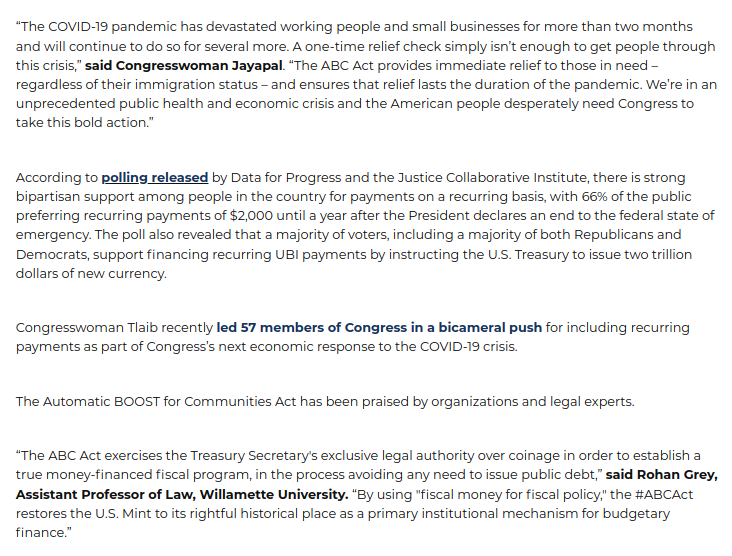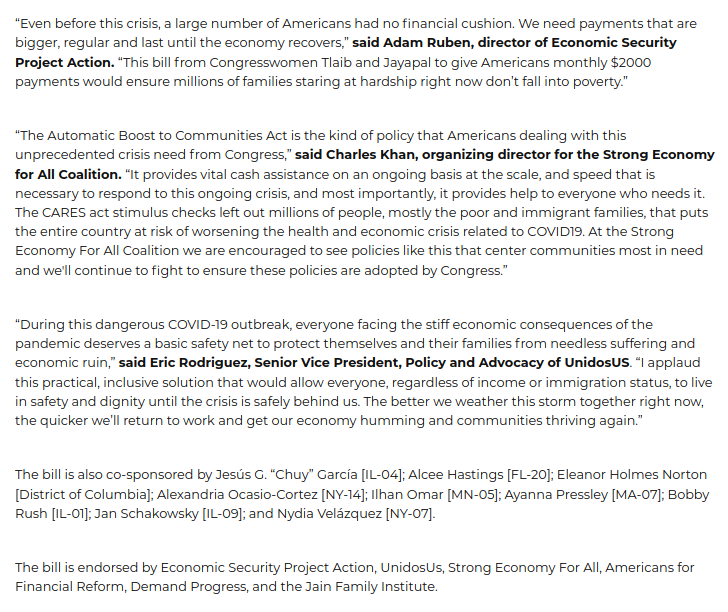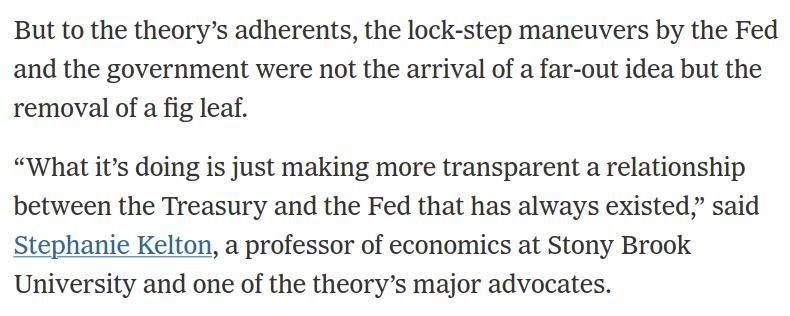
A thread on @RashidaTlaib & @AOC’s new #PublicBanking Act.
tlaib.house.gov/tlaib-aoc-publ…
It was a privilege to help craft this bill with @chastitycmurphy, @claudiapagon, @raulacarrillo, @calpba, @RealBankReform, @TakeOnWallSt, and other great progressive financial reformers.
1/n
tlaib.house.gov/tlaib-aoc-publ…
It was a privilege to help craft this bill with @chastitycmurphy, @claudiapagon, @raulacarrillo, @calpba, @RealBankReform, @TakeOnWallSt, and other great progressive financial reformers.
1/n
Shout out to cosponsors @RepChuyGarcia, @RepJayapal, @RepPressley, @Ilhan, @RepAlGreen, @BennieGThompson, @repblumenauer, @RepBarbaraLee, and @RepSchakowsky, & endorsing orgs, incl. @CJAOurPower, @popdemoc, @PplsAction, @ACREcampaigns, @DemocracyCollab, & @Public_Citizen.
2/n
2/n
Also big thanks for covering to @EmilyStewartM & @voxdotcom:
vox.com/policy-and-pol…
@corbett_jessica & @commondreams:
commondreams.org/news/2020/10/3…
@SylvanLane & @TheHill:
thehill.com/policy/finance…
@ailas & @newsweek:
newsweek.com/reps-tlaib-aoc…
& others
3/n
vox.com/policy-and-pol…
@corbett_jessica & @commondreams:
commondreams.org/news/2020/10/3…
@SylvanLane & @TheHill:
thehill.com/policy/finance…
@ailas & @newsweek:
newsweek.com/reps-tlaib-aoc…
& others
3/n
First, some big-picture comments about the bill.
a) It does *not* create any new public banks. Rather, it *enables & encourages* the creation of public banks by establishing a comprehensive federal regulatory framework, grant programs, & supporting financial infrastructure.
4/n
a) It does *not* create any new public banks. Rather, it *enables & encourages* the creation of public banks by establishing a comprehensive federal regulatory framework, grant programs, & supporting financial infrastructure.
4/n
b) It is designed to foster *state & local public banks*, not establish a federal public bank. In contrast to the federal govt, which issues the $US dollar, state & local govts face unique financial & monetary constraints that public banks can help alleviate.
5/n
5/n
c) It *complements, rather than competes with,* other progressive financial reforms, such as postal banking, FedAccounts, & eCash (on latter, see @RashidaTlaib’s #ABCAct). Together, they envision a new financial system that serves the people & promotes public purpose.
6/n
6/n
d) It does not make the mistake of treating public banks as an alternative to/substitute for federal spending & investment. Rather, it provides “top-down” support for “bottom-up” local initiatives, even while recognizing the critical need for more direct federal action.
7/n
7/n
e) Finally, it does not take a one-size-fits-all approach to the kinds of public banks eligible for federal support. Rather, it accommodates a wide variety of institutional structures and activities, from basic payments to consumer lending to public investment.
8/n
8/n
Okay, now let’s look at what the bill says.
1. Chartering & Licensing
In recognition of the US’s dual banking system (see stlouisfed.org/on-the-economy…), the bill establishes two categories of public banks: a) federal public banks, & b) federally-recognized state public banks.
9/n
1. Chartering & Licensing
In recognition of the US’s dual banking system (see stlouisfed.org/on-the-economy…), the bill establishes two categories of public banks: a) federal public banks, & b) federally-recognized state public banks.
9/n
To qualify as a *public* bank, an entity must be wholly owned/governed by a state/local/Tribal govt, govt-corporation, or govt-approved non-profit, or association thereof, and cannot operate as, or on behalf of, a for-profit entity.
10/n
10/n
In addition, no agent or employee of a public bank may be compensated at a rate higher than the compensation paid to the President of the United States for the equivalent period.
11/n
11/n
Federal public banks can be chartered as either a lending or payments bank. Federal payments banks are limited to providing account and payments services, whereas federal lending banks can also engage in approved credit and lending activities.
12/n
12/n
State public banks are eligible for federal recognition if chartered by a federally-approved state regulator, however they (along with federal public banks) may face additional restrictions depending on the activities they wish to engage in.
13/n
13/n
For example, in order to provide depository services, a public bank must obtain ‘public deposit insurance’ from the FDIC or, for state public banks, an FDIC-approved state alternative. Unlike regular deposit insurance, public deposit insurance is not capped at $250k.
14/n
14/n
Similarly, in order to engage in any securities-related activities, including origination, brokering and dealing, a public bank must obtain an additional ‘public investment entity’ license and be regulated by the SEC.
15/n
15/n
On the other hand, all public banks may function as a:
a) fiscal agent (ie invest funds on behalf of govts & public entities at the Fed),
b) money transmitter, &
c) intermediary for postal banking & federal digital dollar services (ie FedAccounts, eCash).
16/n
a) fiscal agent (ie invest funds on behalf of govts & public entities at the Fed),
b) money transmitter, &
c) intermediary for postal banking & federal digital dollar services (ie FedAccounts, eCash).
16/n
2. Fed Membership & Services
Federal and state public banks are entitled to become “public member banks” of the Federal Reserve system, and enjoy all the rights of commercial member banks, however they are exempt from the historically outdated stock ‘buy-in’ requirement.
17/n
Federal and state public banks are entitled to become “public member banks” of the Federal Reserve system, and enjoy all the rights of commercial member banks, however they are exempt from the historically outdated stock ‘buy-in’ requirement.
17/n
Public member banks can access special Fed services not available to commercial banks. E.g., they may invest funds on behalf of govt customers in ‘fiscal agent accounts’, and on behalf of other customers in ‘payments accounts’, that earn favorable rates of interest.
18/n
18/n
In addition, the Fed is authorized and directed to establish a series of dedicated facilities to provide liquidity and credit to public banks, on favorable terms, against a wide range of collateral, as well as on an unsecured basis.
19/n
19/n
In addition, the Fed is authorized and directed to establish a series of dedicated facilities to provide liquidity and credit to public banks, on favorable terms, against a wide range of collateral, as well as on an unsecured basis.
20/n
20/n
The bill directs the Fed to reimburse public member banks for any costs associated with these accounts/services, as well as the USPS for any costs associated with integrating public banks with postal banking infrastructure.
21/n
21/n
Furthermore, the Fed is directed to provide technical assistance to public banks to “develop, use, and share” financial technologies, practices, and business data to promote public welfare, subject to strict customer privacy requirements.
22/n
22/n
3. Development Grant Programs
Next, the bill establishes 3 development programs to support the creation & ongoing success of public banks, and prohibits them from imposing matching fund requirements or considering the budgetary health of the controlling state/local govt.
23/n
Next, the bill establishes 3 development programs to support the creation & ongoing success of public banks, and prohibits them from imposing matching fund requirements or considering the budgetary health of the controlling state/local govt.
23/n
a) the public bank grant program directs the Fed (& Tsy Secretary) to issue grants to public banks or entities seeking to establish a public bank, for expenses related to formation, capitalization, infrastructure, technology, operations, & unexpected losses.
24/n
24/n
b) the public bank incubator program directs the Fed to establish a program to provide technical and technological assistance to entities seeking a public bank charter, including the creation of a single, streamlined application process.
25/n
25/n
c) the community development grant program awards grants to support partnerships between public banks, community development financial institutions, minority deposit institutions, and credit unions to improve equity/inclusion of financial services.
26/n
26/n
4. Regulation & Guidance
Fourth, the bill establishes federal interest rate caps of 15% on any public bank lending product, prohibits fees and minimum balances on consumer accounts, and prohibits public banks from engaging in or supporting fossil fuel investment.
27/n
Fourth, the bill establishes federal interest rate caps of 15% on any public bank lending product, prohibits fees and minimum balances on consumer accounts, and prohibits public banks from engaging in or supporting fossil fuel investment.
27/n
It also directs the Fed to develop regulations to ensure that public bank activities are consistent with sustainability and climate goals, and “are universal and comprehensively include historically excluded and marginalized groups.”
28/n
28/n
5. Funding
Finally, the bill directs the Fed to establish special accounts, in which expenses incurred under the bill shall be recorded as a ‘deferred asset’, in order to insulate and ringfence them from the Fed’s broader balance sheet and Treasury remittance process.
29/n
Finally, the bill directs the Fed to establish special accounts, in which expenses incurred under the bill shall be recorded as a ‘deferred asset’, in order to insulate and ringfence them from the Fed’s broader balance sheet and Treasury remittance process.
29/n
To conclude, Public Banking is not a panacea, and should not be misused or relied on when other public financing approaches are more suited to the problem at hand. Nevertheless, they represent a critical step towards building a more democratic economy and financial system.
30/n
30/n
Banking is social infrastructure, and is intimately dependent upon public support and regulation. To that extent, public banking is not ‘extreme’ or an ‘aberration’. To the contrary, it restores banking to its proper role as a tool of public development.
31/n
31/n
I’m thrilled to support this bill, and the broader vision of economic justice of which it is but one part, and hope you will too.
32/n.
32/n.
• • •
Missing some Tweet in this thread? You can try to
force a refresh










